Yii directory structure, entry file and routing settings
This article mainly introduces the directory structure, entry files and routing settings of Yii. It has certain reference value. Now I share it with you. Friends in need can refer to it.
This article starts from the directory of YII Starting from the structure analysis, to the entry file analysis, to the detailed explanation of routing settings, and the detailed explanation of views, it comprehensively shows us all aspects of the YII framework. It is a very good article, and I recommend it to everyone.
The project name was changed from "FantaCMS" to "testyii" ———— Custom!
1, Project directory structure analysis

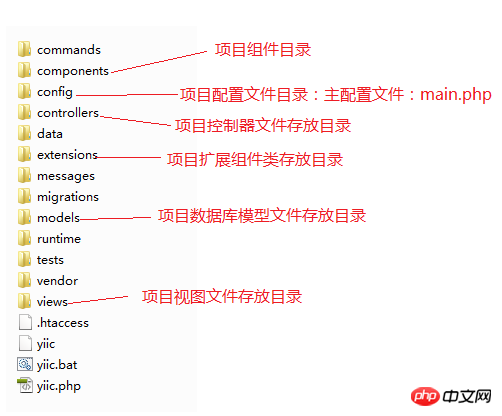
2, Yii entry file analysis
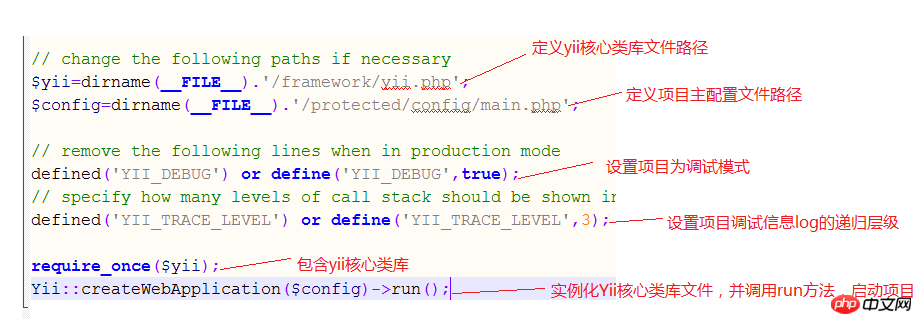
When Yii starts the project, the project main configuration file array is passed, then Yii will bind a global to the entire application Yii object and can be called by the following method: Yii::app()
The Yii system binds the array value in the configuration file to the object in the form of key-value pairs, for example, in In the configuration file, we configured:
'name'=>'My Web Application',
Then we can get "name" through the properties of the object anywhere in the project ” value, the method is:
Yii::app()->name;
3, Yii routing settings

At the same time, you should know: For the controller name, Yii will first detect whether the current controller name is a "module name", and if it is a module name, it will first locate the module.
"Module" will be explained later when building the project.
What is accessed through the above route is: the actionIndex method in the SiteController class under the SiteController.php class file
The controller file is located in: protected/controllers directory, which is our control Controller file storage directory
Pay attention to the way controller files and action method names are written in Yii. Controllers have a unified suffix "Controller", and action methods also have a unified prefix "action". At the same time, the action method name is required The naming convention conforms to "the first letter of each word except the first word must be capitalized"
Because the default controller name of Yii is: site
The default action name is: index
Therefore, the above path accessed by specifying the controller name and action name has the same effect as direct access: http://localhost/testyii/
4, view call
In the action method, call: $this->render('index');
to specify the view file for the corresponding action method. The view file is located at: protected/ Views/site directory
Where: site is the corresponding controller name folder, each controller name should have a unique folder name corresponding to it in the view
Then The specific view file displayed through 'index' in the action method is the specified 'index.php' view file under the site controller
Also note:
Calling the view There are two methods:
$ this-& gt; render ---- & gt; will call template files
# and
## $ This-& gt --------------------------------- -> The template file will not be calledThe difference between them is also as mentioned above.5, view template settings
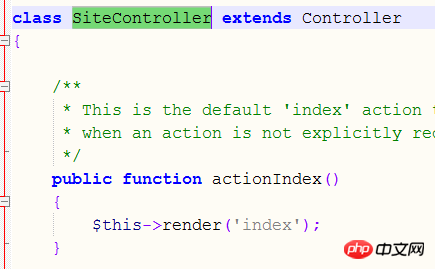

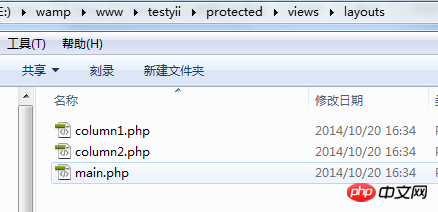
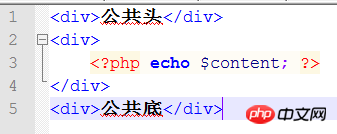
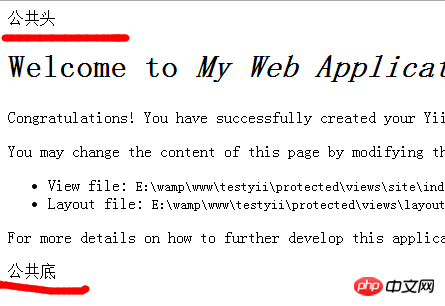
Then we found that the template file has become our own specification, and if you do not need the view file to render the template file, then you can call the view file in the action method Use: $this->renderPartial method
Or you don’t need to call the template file in the entire project, then you can use all of them when calling the view file in the action method: $this->renderPartial
Or set the view template file to "empty", for example: public $layout='';
Continue in the next section: Yii's magician: gii, Yii modules and module customization
Related recommendations:
yii’s urlManager component configuration
##
The above is the detailed content of Yii directory structure, entry file and routing settings. For more information, please follow other related articles on the PHP Chinese website!

Hot AI Tools

Undresser.AI Undress
AI-powered app for creating realistic nude photos

AI Clothes Remover
Online AI tool for removing clothes from photos.

Undress AI Tool
Undress images for free

Clothoff.io
AI clothes remover

AI Hentai Generator
Generate AI Hentai for free.

Hot Article

Hot Tools

Notepad++7.3.1
Easy-to-use and free code editor

SublimeText3 Chinese version
Chinese version, very easy to use

Zend Studio 13.0.1
Powerful PHP integrated development environment

Dreamweaver CS6
Visual web development tools

SublimeText3 Mac version
God-level code editing software (SublimeText3)

Hot Topics
 1378
1378
 52
52
 How to recover expired WeChat files? Can expired WeChat files be recovered?
Feb 22, 2024 pm 02:46 PM
How to recover expired WeChat files? Can expired WeChat files be recovered?
Feb 22, 2024 pm 02:46 PM
Open WeChat, select Settings in Me, select General and then select Storage Space, select Management in Storage Space, select the conversation in which you want to restore files and select the exclamation mark icon. Tutorial Applicable Model: iPhone13 System: iOS15.3 Version: WeChat 8.0.24 Analysis 1 First open WeChat and click the Settings option on the My page. 2 Then find and click General Options on the settings page. 3Then click Storage Space on the general page. 4 Next, click Manage on the storage space page. 5Finally, select the conversation in which you want to recover files and click the exclamation mark icon on the right. Supplement: WeChat files generally expire in a few days. If the file received by WeChat has not been clicked, the WeChat system will clear it after 72 hours. If the WeChat file has been viewed,
 Photos cannot open this file because the format is not supported or the file is corrupted
Feb 22, 2024 am 09:49 AM
Photos cannot open this file because the format is not supported or the file is corrupted
Feb 22, 2024 am 09:49 AM
In Windows, the Photos app is a convenient way to view and manage photos and videos. Through this application, users can easily access their multimedia files without installing additional software. However, sometimes users may encounter some problems, such as encountering a "This file cannot be opened because the format is not supported" error message when using the Photos app, or file corruption when trying to open photos or videos. This situation can be confusing and inconvenient for users, requiring some investigation and fixes to resolve the issues. Users see the following error when they try to open photos or videos on the Photos app. Sorry, Photos cannot open this file because the format is not currently supported, or the file
 Can Tmp format files be deleted?
Feb 24, 2024 pm 04:33 PM
Can Tmp format files be deleted?
Feb 24, 2024 pm 04:33 PM
Tmp format files are a temporary file format usually generated by a computer system or program during execution. The purpose of these files is to store temporary data to help the program run properly or improve performance. Once the program execution is completed or the computer is restarted, these tmp files are often no longer necessary. Therefore, for Tmp format files, they are essentially deletable. Moreover, deleting these tmp files can free up hard disk space and ensure the normal operation of the computer. However, before deleting Tmp format files, we need to
 What to do if the 0x80004005 error code appears. The editor will teach you how to solve the 0x80004005 error code.
Mar 21, 2024 pm 09:17 PM
What to do if the 0x80004005 error code appears. The editor will teach you how to solve the 0x80004005 error code.
Mar 21, 2024 pm 09:17 PM
When deleting or decompressing a folder on your computer, sometimes a prompt dialog box "Error 0x80004005: Unspecified Error" will pop up. How should you solve this situation? There are actually many reasons why the error code 0x80004005 is prompted, but most of them are caused by viruses. We can re-register the dll to solve the problem. Below, the editor will explain to you the experience of handling the 0x80004005 error code. Some users are prompted with error code 0X80004005 when using their computers. The 0x80004005 error is mainly caused by the computer not correctly registering certain dynamic link library files, or by a firewall that does not allow HTTPS connections between the computer and the Internet. So how about
 How to transfer files from Quark Cloud Disk to Baidu Cloud Disk?
Mar 14, 2024 pm 02:07 PM
How to transfer files from Quark Cloud Disk to Baidu Cloud Disk?
Mar 14, 2024 pm 02:07 PM
Quark Netdisk and Baidu Netdisk are currently the most commonly used Netdisk software for storing files. If you want to save the files in Quark Netdisk to Baidu Netdisk, how do you do it? In this issue, the editor has compiled the tutorial steps for transferring files from Quark Network Disk computer to Baidu Network Disk. Let’s take a look at how to operate it. How to save Quark network disk files to Baidu network disk? To transfer files from Quark Network Disk to Baidu Network Disk, you first need to download the required files from Quark Network Disk, then select the target folder in the Baidu Network Disk client and open it. Then, drag and drop the files downloaded from Quark Cloud Disk into the folder opened by the Baidu Cloud Disk client, or use the upload function to add the files to Baidu Cloud Disk. Make sure to check whether the file was successfully transferred in Baidu Cloud Disk after the upload is completed. That's it
 192.168.0.1 entrance Where is the 192.168.0.1 login entrance?
Feb 22, 2024 pm 03:01 PM
192.168.0.1 entrance Where is the 192.168.0.1 login entrance?
Feb 22, 2024 pm 03:01 PM
The login method for the 192.168.0.1 portal is: enter http://192.168.0.1 in the address bar of the browser. The login method for analyzing the 1168.0.1 entrance is: enter http://192.168.0.1 in the address bar of the browser. After entering the account password, you can enter a page and set or change relevant important network parameters. This URL is usually the login page of routers from brands such as Tenda, Cisco, D-X, and Links. If you cannot enter the management interface after entering it, it means the address is wrong. Supplement: What does 192.168.0.1 mean? 1168.0.1 is a Class C private IP address. To put it simply, 192.168.0.1 is an IP address.
 Different uses of slashes and backslashes in file paths
Feb 26, 2024 pm 04:36 PM
Different uses of slashes and backslashes in file paths
Feb 26, 2024 pm 04:36 PM
A file path is a string used by the operating system to identify and locate a file or folder. In file paths, there are two common symbols separating paths, namely forward slash (/) and backslash (). These two symbols have different uses and meanings in different operating systems. The forward slash (/) is a commonly used path separator in Unix and Linux systems. On these systems, file paths start from the root directory (/) and are separated by forward slashes between each directory. For example, the path /home/user/Docume
 What is hiberfil.sys file? Can hiberfil.sys be deleted?
Mar 15, 2024 am 09:49 AM
What is hiberfil.sys file? Can hiberfil.sys be deleted?
Mar 15, 2024 am 09:49 AM
Recently, many netizens have asked the editor, what is the file hiberfil.sys? Can hiberfil.sys take up a lot of C drive space and be deleted? The editor can tell you that the hiberfil.sys file can be deleted. Let’s take a look at the details below. hiberfil.sys is a hidden file in the Windows system and also a system hibernation file. It is usually stored in the root directory of the C drive, and its size is equivalent to the size of the system's installed memory. This file is used when the computer is hibernated and contains the memory data of the current system so that it can be quickly restored to the previous state during recovery. Since its size is equal to the memory capacity, it may take up a larger amount of hard drive space. hiber




